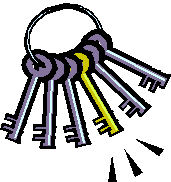Mastering the ART of Communication
The Essentials of Communications
Techniques for Effective Listening
Six Keys to Healthy Communication
I refer to communications as an art; it is also a skill that can be developed. Good communication skills can open the door to financial wealth, loving relationships, and all that is wonderful in life. As in any art media the more you express your self the better your skill becomes. Communications is the most talked about and least understood mode of human behavior. I will discuss communications and not to conversation. As humans we have the unique ability to communicate in many modes. People who can’t speak often have great and expressive styles of communication. Communication is also a receptive tool where we function as receivers of another’s expressive verbal or non-verbal message. Superior communication skills pave the way to living a full and productive life.
Interpersonal communications require several basic components –
effective and great communications have need of a more complex combination of
parts. Often these elements
are just plain part of a person’s nature or they are skills that the
accomplished communicator developed and learned over time.
Some elements of communications have to be heavily considered and often
eliminated in the process of effective communications.
Knowledge of all components will assist the communicator.
The essentials of communications
are: 
1. The transmitter; someone sending the verbal or non-verbal message.
2. The receiver; someone receiving the verbal or non-verbal message.
3. The message; information is any shape, size or form. This message can be tangible or intangible, concrete or abstract, spoken or silent. The goal of the communication is the delivery of this entity.
4. Distractions or noise; “noise in the tunnel”, misinterpretations, deletions or generalizations. Knowledge of human nature and emotions is often a benefit in this area.
5. Knowledge and understanding; an approximation of what the message is from the sender by the receiver and the reverse.
6. Feedback; both transmitter and receiver consistently exchange expressions of their understandings to each other – verbally or non-verbally. Often clarifying the communications by the artful use of questions.
7. And finally – replication; which is the duplication of understanding of the approximate goal of the communication by the transmitter and the receiver – after the elimination of the noise and distractions. Understanding the intent of the communication.
Most important to mastering great communications is to develop....
Listening
Skills: 
All communicators and especially leaders and managers need to develop their listening skills! You know what?? Everyone needs to develop his or her listening skills! It’s just plain courteous!
Effective listening skills should be required learning for anyone wanting to succeed in business. It is relevant to all professions and all situations where someone wants to be successful and connect with people in an authentic and comfortable way. Listening skills are extremely important for all relationships - whether in business, in the schools, at home or just even at a gathering of friends.
For
now, however, our focus will be on the manager’s command of listening skills.
Listening more, talking less, that should be a key phrase for every manager, parent, spouse and friend. In business, become the manager that employees can open up to, respect and admire. Communications experts all agree; being a good listener is one of the critical skills a manager needs to be successful in business. Listening - aids the business leader in developing rapport. Listening - builds trust and conveys openness to hearing all the concerns and new ideas. Whether sitting down with a business client, meeting with an associate or receiving input from an employee, managers must listen not only to what is being said, but how it is said or not said.
Think
about the power of your knowledge of NLP (visit our page on Neuro Linguistic
Programming ) working while you listen. Use these tools to
understand the person being listened to. Tone of voice, demeanor, or
absence of a response, awareness of sub-modalities can often give as much
information as words and gestures can. Body language speaks, A good
ear and eye goes a long way. Those who listen effectively and intently are
perceived to be great communicators, even without saying a word. Good listeners
are viewed to be caring and wise as well. In return, because they listen
well, when they do speak, people give what they say much more attention.
A
good rule of thumb: listening first, then tailor your message to what you have
heard. As you listen, you can learn about a person, you can understand his
values, experiences, feelings, attitudes and modalities. This information
will enable you to devise messages that are going to be more appealing.
Good
listening is directed by two elements: What is being said & How it is being
said.
·
What is being said?
·
What is their view of the topic being discussed?
·
What arguments are being used?
·
What do they look to accomplish or what goals need to be achieved?
·
What emotions are expressed, where do they occur and where are they emphasized?
Is it anger, fear, and delight? Pay special attention to what is being
said the moment that emotion is detected.
·
What is behind these feelings? There is nothing wrong with analyzing the
situation.
Observe
how they are communicating:
·
How is it being said? Be aware of body language; Foot-flapping (anxiety or
discomfort reaction), nose touching (not being completely honest or having
anxiety about being exposed), leaning away (desire for distance), crouched or
slumped posture (may mean defensiveness), crossed arms (defensiveness).
·
How are they using their facial expressions? Carefully observe all facial
expressions. What is the speaker talking about when he smiles or frowns?
·
How intense and direct is eye contact? Most importantly be aware of eyes, eye
contact, eye movement and even possible expressions of emotions. The eyes
are the windows to the soul and can give away big secrets.
Techniques
for Effective Listening:
Take
a lot of notes. Note taking makes a person feel important. It also will
give your an opportunity to review the conversation later. Telling a person 'to
expand on that' makes communication stronger and encourages clarification. A
manager who sits back and just listens makes the speaker the single most
important person at the time. You're focusing on the individual. Taking notes as
you listen and underlining words is also useful when you want to incorporate
these words or ideas into your responses. Note pads and pens at all
meetings and on your office desk are handy tools to being properly armed to
actively listen.
Hold
weekly meetings with all staff members with no formal agenda, just to listen to
what comes up and take the pulse of what is happening with each team member.
Listen at meetings to everyone’s agenda. At “Brainstorming”
sessions stress listening to everyone's contributions before formulating any
reply. Good listening skills practiced at meetings and in your office helps
create an environment where people feel secure, loved and valued so that they
could be truly brilliant and not constantly looking over their shoulders or
covering their backs because the work environment gets to feel like a political
snake-pit. The best listening can only take place when there is an open
environment and mutual trust.
Let
go of Ego issues. The best listeners are those who really care about
another’s opinion and do not assume that they have all the answers themselves.
Everyday politeness says we let people finish their thoughts, all too often we
assume that we know what they are going to say and interrupt. We just
interrupt because we want to hear what we're going to say - the ultimate ego
trip!
Rephrase
what is being said. When a person is through talking, give him the
opportunity to say more and then rephrase what he's said to make sure it was
understood. This form of listening provides the speaker with feedback and the
opportunity to clarify his point. This focused listening is crucial when
working with clients and job candidates. To place the right candidates in the
right jobs, listens closely to needs, requirements, desires and goals. For
clients, focus on their expectations. Use phrases such as:
o
"So what you're thinking is this..."?
o
"Do I understand that…”?
o
“So what you are saying is…”?
o
“ I wonder if you could give examples for clarification.”
Ask
the right questions. You can't do that if we haven't really heard
the candidate or the client. To show you're really listening, you have to ask
questions that generate more dialogue. Asking the appropriate questions is
truly the best way for practice active listening. But be careful not to
over do with the questions.
Empathize.
Hear the person, pause and repeat back verbatim what the other person has said.
As in rephrasing, capture the essence of what is being said by summarizing.
Capture the feeling and meaning of what someone has said. Express your
true concern. If you have no concern by all means just listen and don’t
try empathy. When risking false emotions you will come across as a fool.
Avoid
the danger of listening too late. How often we hear that management
doesn’t know that a problem exists until the exit interview. That one
bites. All too often issues come up with the human resource department
about happenings that frustrated and employee to the point of resigning.
Avoid this situation by keeping the pulse on your staff by listening. You
will be able to led the team more effectively if you know what's going on inside
with their internal realities.
Listen
to the noise (the words) and the silences (what is not said or often what is
screamed in behavior and body language). Teachers and parents often learn
the hard way about those issues! Don’t assume that because someone is an
adult that they have resolved all their adolescent issues. And don’t
just assume that a pause means someone is finished. A good technique is to
take a breath and to not just jump in when someone pauses or appears to be
finished,
Stay
Focused. Here’s the hard one… this is where I usually bite my inner
lip or even clench a hand or pen. I find myself always wanting to butt in
with my too cents. Or I just am getting bored. Do not let your attention
wander and (unless you are taking notes) certainly do not do anything else.
There is nothing worse that having a discussion with someone that is distracted
and shuffling papers or playing with something on the desk.
Positioning
and posture has a lot to do with active listening. Someone who's sitting
there with his hands clasped in front and looking directly at you and digesting
what you are saying, is essentially saying, 'Let me think about that for a
moment, I hear what you have said and then I'll respond. There is great
emotional pleasure in this for the one who's doing the talking. This
receptive approach is also an effective active listening device.
Signs of a Poor Listener…
Besides
being someone with no friends or a boss that no one likes - there are
other signs of a poor listener. Some obvious signs that someone is not
listening are:
·
Constantly interrupting
·
Looking around the room or off into the distance
·
Fidgeting or distracting hand movements – picking at nails etc.
·
Talking on and on without pause
·
Not seeking information or ideas through proper questioning
·
Multi-tasking (as when on the phone & you can hear someone typing away!)
·
When people start cutting you off
·
Answers with a response that is slightly off
·
Lack of eye contact (most obvious sign)
·
When something goes "In one ear out the other” and they return 10 minutes
or two days later asking for information about the conversation.
A good place to start with communication skill development is by listening!! This skill and this art will take you very far on your journey into the world of effective communicating.
Knowing what
you want in your communications:
As in any aspect of life – goal setting is an extremely
powerful tool. It is a way of staying focused.
On a more personal level....
 Six
Keys to Healthy Communication
Six
Keys to Healthy Communication
1.
Listen carefully to what people say. Read the above advice - it is
critical.
Don't rush to make a comment or give advice.
Listen for facts and sense the emotions.
What is the purpose and intent of the speaker?
What do you think their goal is in sharing their information?
2.
Compose your message carefully take your time - use silence as a tool.
Consider your goals and the goals of the other person. Stay focused
Is this the right time and place to deliver your message?
What are the potential consequences of delivering this message?
Do you have a long-term relationship with this person?
Is the relationship important to you and could it be negatively impacted by your
message?
3.
If you make a mistake, admit it and do your best to pull through it.
The sooner you deal with negative feelings, the easier it is work out things
& get back 'on track' to achieve positive results.
Cooperation is more valuable than destructive competition.
4.
At times emotions are so strong that it is difficult to say things in a
constructive way.
At these times choose to 'cool off' - take a 'timeout' or to clear the air &
allow the other person to know how you feel.
This is a judgment call - experience is the best teacher.
Be gentle with yourself and others.
We tend to judge ourselves by our intentions and others by their behavior.
5. Be patient - be tolerant of another person's communicating techniques! They will learn from your example - never correct someone mid sentence or for that matter ever! Unless it is your position to do so - as a teacher, parent or mentor! This is a very sensitive position to be in... tread carefully!
6.
Forgiveness is critical to maintaining healthy relationships.
Whatever happens, you can choose how to react.
Healthy communications is the result of effort and wise choices.
None of us is perfect. Everyone makes mistakes and we can all learn from
experience.
Ask yourself in a negative situation "Is it better to be right or
happy?"
Then choose accordingly and know that each day can be a new beginning.
You can start over at any time and find an alternative to the way you
communicate - with yourself and others.
Learn to forgive yourself and others for mistakes.
Take reasonable risks and learn from the experience.
